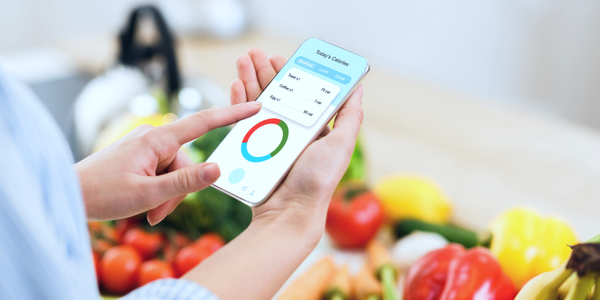
Looking for a carb counter app? Learn everything you need to know about carbohydrate counters and carb counting for diabetes right here.
Read on to discover how to count net carbs and more.
Types of Carbohydrates
Many associate carbs with weight gain and bloating. However, quality carbohydrates (such as whole grains) are needed to support the body in accomplishing its normal functions.
Even diabetics, who need to be aware of how many carbohydrates they are consuming, use carbs to function. However, chronic conditions like type 2 diabetes occur when a person eats too much sugar. Too much sugar can raise blood sugar to dangerous levels.
Overall, carbohydrates provide fuel for the body along with other vitamins and minerals. There are three main forms of carbohydrates that the body comes in contact with.
Starch
Starches are a type of carbohydrate found in plant-based foods and grains. Some foods that include starches are:
• Breads
• Beans
• Cereal
• Corn
• Pasta
• Peas
• Potatoes
• Rice
• Starchy vegetables (i.e. potatoes)
Sugar
Another type of carbohydrate is sugar. Natural sugars are found in fruit in milk and can contribute to a healthy, balanced diet. Other foods that contain sugars include:
• Dried fruit
• Syrups & honey
• Yogurt
Added sugars, however, tend to be found in highly processed foods. These foods often contain higher amounts of salt, saturated fat, and nutrient-poor carbohydrates:
• Cake
• Candy
• Cookies
• Soft drinks
Carbohydrates from food are turned into glucose (blood sugar), which causes blood sugar to rise. In normal cases, the pancreas supplies insulin to the body, which helps to balance blood sugar levels.
However, in those with diabetes, the body is unable to properly produce insulin and circulating blood sugar can get too high.
Dietary Fiber
Fiber is an indigestible type of carb, but it has the power to improve digestion. It isn't used for fuel like starches and sugars, but does provide the body with some small amounts of energy. While mostly known to add bulk to the body’s stool, fiber can also help with digestion (prevents constipation), diabetes, heart conditions, and weight management.
Foods that contain fiber are plant-based, including:
• Beans and legumes
• Fruits and vegetables
• Oats
What Is a Carb Counter?
Carb counters can be a useful treatment tool for people who want to keep an eye on their blood sugar. Carb counting is actually a diabetes meal planning technique and can help individuals to keep track of the amount of carbs in snacks, meals, drinks, and more.
Traditionally, dietitians and people with diabetes were the only ones who were trained in carb counting. With advancements in technology, carb counting apps have become available. That means better health is, essentially, at one's fingertips.
Benefits of Carb Counting
Carb counting supports the main health goals an individual (diabetic or not) might be working towards, including:
1. Balancing blood sugar: Keeping blood glucose levels in the normal range, which is under 140 mg/mL (7.8 mmol/L).
2. Balancing blood pressure: Keeping blood pressure in normal range, which is defined (for adults) as a systolic pressure of less than 120 and diastolic pressure of less than 80 (often read as 120/80). Blood pressure is highly impacted by diet and weight, thus making carb counters helpful for tracking dietary habits and patterns.
3. Balancing cholesterol: Keeping total cholesterol in the normal range, which (for adults older than 20 years of age) is between 125 and 200 mg/dL. Carb counters help by tracking sugar intake, which is known to impact blood cholesterol.
4. Managing portions: Whether for weight loss or healthier eating, carb counters can help control portion and serving sizes.
All four of these elements contribute to a healthy diet and overall health. Whether one is battling prediabetes or just wanting to stay healthy, carb counting can be a great skill to learn (before it is too late).
Carb counting can also be less restrictive than other methods of treatment. Focusing on carb counting also tends to promote a higher fiber intake and reduce the risk of hypoglycemia in people who use insulin. While it is not 100% accurate on its own, carb counting is a great method to combine with other treatment options.
Best Carb Counter App
So, what is the best carb counter/tracker app? The simple answer is that it depends on the person.
There are many apps out there that measure the components of food. Depending on overall fitness or health goals, the "best" app will differ.
Most experts recommend an app like Daily Carb Pro that focuses on glucose tracking and carb counting rather than controlling calorie intake. For diabetics, many modern glucose monitors come with an app for easy tracking of blood sugar and personalized recommendations for balance.
Often, the best thing an individual can do is learn how to properly use the medical devices available to them for treatment and management of their disease. Understanding individual normal ranges can help one customize a treatment plan to their own needs.
Apps and technology are certainly helpful, but investing time with healthcare providers, dietitians, and other experts to truly learn carb tracking can also be invaluable.
How to Calculate Net Carbs
For diabetics and those wanting to keep an eye on carbs, learning to calculate net carbs is incredibly important.
Net carbs are also called digestible carbs or impact carbs. These are carbs that the body absorbs and include two types of carbohydrates:
• Simple carbs: one or two sugar links, commonly found in fruits, vegetables, milk, and syrups
• Complex carbs: contain many sugars linked together (more than two), and are commonly found in grains and potatoes
Some of the carbs consumed by the body can't be broken down into individual sugars to be absorbed. These include fiber and most sugar alcohols (e.g. erythritol, isomalt), which are subtracted from total carb counts to produce net carbohydrates.
Generally, the number of net carbs can be found using this simple formula:
Grams of total carbohydrates - grams of fiber = grams of net carbs
Once sugar alcohols come into play, things can get tricky. It is best to talk to a healthcare expert in order to individualize a "game plan" for sugar alcohols since they are an ingredient that interacts with everyone differently.
In Conclusion on Carbohydrate Counters
Learning how to count carbohydrates and net carbs and utilize carb counter apps can be useful. These skills are useful for individuals with diabetes, as well as those who want to use carb counters for the benefit of watching cholesterol and blood pressure, too.
The “best” carb counter will be different for everyone, so it's important to work closely with healthcare providers to find customizable care options.
References:
Cervoni B. Normal Cholesterol Levels by Age. Verywell Health. Published October 30, 2021. https://www.verywellhealth.com/cholesterol-levels-by-age-chart-5190176.
Desoto L. A Guide to Carb Counting With Diabetes. Verywell Health. Published December 10, 2021. https://www.verywellhealth.com/carb-counting-and-diabetes-5209223.
Diabetes. Mayo Clinic. Published October 30, 2020. https://www.mayoclinic.org/diseases-conditions/diabetes/diagnosis-treatment/drc-20371451#:~:text=A%20blood%20sugar%20level%20less,mmol%2FL%20 indicates%20prediabetes.
Ellis E. Carbohydrates — Part of Healthful Diabetes Diet. Eat Right. Published November 16, 2020. https://www.eatright.org/health/diseases-and-conditions/diabetes/carbohydrates-part-of-a-healthful-diabetes-diet.
Ellis E. Understanding Diabetes. Eat Right. Published November 5, 2021. https://www.eatright.org/health/diseases-and-conditions/diabetes/understanding-diabetes.
Spritzler F. How to Calculate Net Carbs. Healthline. Published May 10, 2017. https://www.healthline.com/nutrition/net-carbs.







